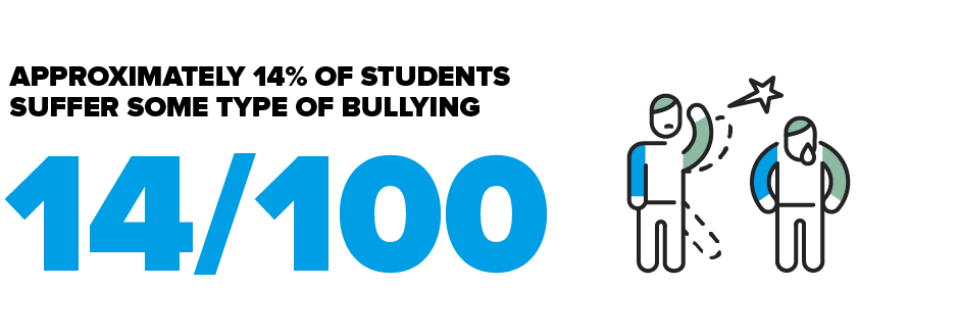What is Bullying?
Bullying is understood as any form of physical, verbal, social or psychological abuse that occurs repeatedly among minors or adolescents in school settings.
Bullying in first person
Bullying can be prevented through a culture of respect and emotional control, that is, we should include emotional education programmes based on respect, values, non-violence, the peaceful resolution of conflicts, etc. into the school curriculum... These are values that are as important as mathematics or learning to read.
Where does bullying happen?
Bullying can happen in various spaces, such as:
- In school facilities, including classrooms, corridors, courtyards or bathrooms.
- In school-related settings, such as school transportation or extracurricular activities.
- Today, bullying also occurs online thanks to the use of mobile devices and the Internet. This type of bullying, known as cyberbullying, occurs through text messages, emails, calls, social media posts, or instant/direct messages.
What is considered bullying?
For a behaviour to be considered bullying, certain criteria must be met:

Agression. It can manifest in different ways:
- Physical. Physical aggression occurs when the bully causes physical harm to another person or their belongings. For example, pushing, tripping or breaking personal objects.
- Verbal. Verbal aggression includes insults, mockery, threats or any offensive communication, whether in person or through written messages.
- Social. Social aggression affects the relationships or reputation of the person being bullied. This may include intentionally excluding them from activities, prohibiting others from engaging with them, or spreading false or private information (in person or on social media).

Power imbalance. This occurs when the bully uses their position of power to control, intimidate, or harm. This power can be based on:
- Greater physical strength.
- A position of popularity or influence.
- Access to private information that can be used to harm.

Repetition. Bullying is characterised by repetitive behaviour, that is, it is perpetuated over time.
Bullying Examples
The following are situations that can be considered bullying:
- Spreading lies or false accusations. Example: a group of students causes damage to school furniture and, when confronted, blame someone else who was not involved in the events.
- Bullying for economic reasons. Example: a student is taunted by peers for not wearing branded clothing or having access to certain resources.
- Bullying due to sexual orientation. Example: a teenager receives death threats because of their sexual orientation.
- Bullying motivated by jealousy. Example: a teenager is bullied by their classmates for having a relationship with a popular student at school.
- Use of fake profiles on social media. Example: a student creates a fake social media account, impersonates someone else, and starts an online relationship with a peer. By earning their trust, they spread private information among other people.
- Dissemination of intimate content without consent (sexting). Example: a teenager shares an intimate photo with her partner. After the relationship ends, this image is disseminated among her peers, who insult her through text messages and social media.
How to deal with Bullying
Identifying bullying is the first step in dealing with it. If you recognise yourself in any of these situations, whether as a victim, witness or person involved, it is important to take action. Seek support from trusted adults, such as teaching staff, counsellors or family members.
Remember: Bullying is harmful behaviour that affects everyone involved. Together we can prevent it and build safe and respectful spaces.
Who participates in bullying?
In a bullying situation, the people doing the bullying and the people being bullied are not the only participants. Some researchers talk about a "bullying circle" which includes people who support or reject bullying, as well as those directly involved in aggressive behaviour.
People directly involved in bullying:
- Children who bully others. They behave aggressively to their classmates.
- Children who are bullied. They are the targets of the aggressive behaviour.
People indirectly involved in bullying:
- Children who assist. They may not start the bullying behaviour, but they serve as "assistants" to children who are bullying.
- Children who reinforce. They are part of the audience and laugh at the bullying behaviour, encouraging the bullying to continue.
- Outsiders. These children remain separate from the bullying situation; they do not reinforce the bullying behaviour, but they do not defend the child being bullied. They are part of the audience and this may also encourage the bullying to continue.
- Children who defend. They actively comfort the child being bullied and may come to their defence when bullying occurs.
Over time, children may play more than one role. In some cases, they may take part directly in bullying, and in others they may witness the situation and play an assisting or defending role.
How common is Bullying?
In Spain, around 14% of students say they have been bullied at school in some way. This figure is lower than in countries like Latvia (30.6%), New Zealand (26.1%) and the Czech Republic (25.4%) and higher than others such as the Netherlands (9.3%), Portugal (11.8%), South Korea (11.8%) and Iceland (11.8%).
Related contents
Información general de Mental Health in Children and Adolescents
Consulta toda la información relacionada con Mental Health in Children and Adolescents
Read moreSubstantiated information by:

Published: 3 October 2019
Updated: 2 April 2025
Subscribe
Receive the latest updates related to this content.
(*) Mandatory fields
Thank you for subscribing!
If this is the first time you subscribe you will receive a confirmation email, check your inbox
